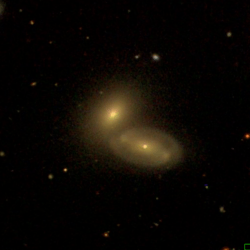NGC 78
| NGC 78 | |
|---|---|
 SDSS image of NGC 78A (bottom right) and 78B (top left) | |
| Observation data (J2000 epoch) | |
| Constellation | Pisces |
| Right ascension | 00h 20m 27.482s[1] |
| Declination | +00° 50′ 00.96″[1] |
| Redshift | 0.018283[2] |
| Helio radial velocity | 5079 km/s[2] |
| Apparent magnitude (B) | 14.5[3] |
| Characteristics | |
| Type | SB0/a?(r)[2] |
| Size | 84,100 ly (25,790 pc)[2][note 1] |
| Apparent size (V) | 1.3′ × 0.897′[2][note 1] |
| Other designations | |
|
NGC 78A: UGC 193, MGC+00-02-004, PGC 1306[3] | |
NGC 78 is a pair of galaxies in the constellation Pisces.[2] NGC 78A, which is the more southern galaxy, is a barred spiral galaxy.[2] NGC 78B, which is the more northern galaxy, is an elliptical galaxy.[4] Although the designations NGC 78A and 78B are used today, the designation NGC 78 was formerly used mainly for the northern galaxy.[5]
NGC 78 was discovered no later than 1876 by Carl Frederick Pechüle.[5] It was described as "very faint, small, round" by John Louis Emil Dreyer, the compiler of the New General Catalogue.[5] Because the two galaxies have different recessional velocities, the two galaxies are most likely not interacting.[5]
References
- 1 2 Skrutskie, M. (2006). "The Two Micron All Sky Survey (2MASS)". The Astronomical Journal. 131 (2): 1163–1183. Bibcode:2006AJ....131.1163S. doi:10.1086/498708.
- 1 2 3 4 5 6 7 "NED results for object NGC 0078A". National Aeronautics and Space Administration / Infrared Processing and Analysis Center. Retrieved 6 September 2017.
- 1 2 "NGC 78A". SIMBAD. Centre de données astronomiques de Strasbourg. Retrieved 6 September 2017.
- 1 2 "NGC 78B". SIMBAD. Centre de données astronomiques de Strasbourg. Retrieved 6 September 2017.
- 1 2 3 4 "New General Catalog Objects: NGC 50 - 99". cseligman.com. Retrieved 6 September 2017.
Notes
This article is issued from
Wikipedia.
The text is licensed under Creative Commons - Attribution - Sharealike.
Additional terms may apply for the media files.